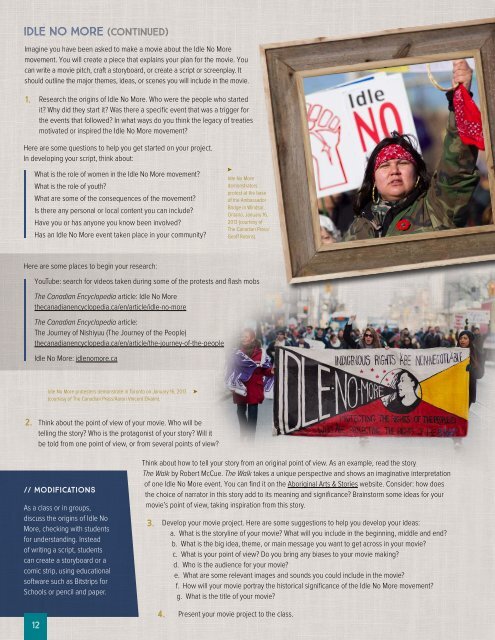TREATIES IN CANADA
teWu3043CBd
teWu3043CBd
Create successful ePaper yourself
Turn your PDF publications into a flip-book with our unique Google optimized e-Paper software.
IDLE NO MORE (continued)<br />
Imagine you have been asked to make a movie about the Idle No More<br />
movement. You will create a piece that explains your plan for the movie. You<br />
can write a movie pitch, craft a storyboard, or create a script or screenplay. It<br />
should outline the major themes, ideas, or scenes you will include in the movie.<br />
1.<br />
Research the origins of Idle No More. Who were the people who started<br />
it? Why did they start it? Was there a specific event that was a trigger for<br />
the events that followed? In what ways do you think the legacy of treaties<br />
motivated or inspired the Idle No More movement?<br />
Here are some questions to help you get started on your project.<br />
In developing your script, think about:<br />
What is the role of women in the Idle No More movement?<br />
What is the role of youth?<br />
What are some of the consequences of the movement?<br />
Is there any personal or local content you can include?<br />
Have you or has anyone you know been involved?<br />
Has an Idle No More event taken place in your community?<br />
Idle No More<br />
demonstrators<br />
protest at the base<br />
of the Ambassador<br />
Bridge in Windsor,<br />
Ontario, January 16,<br />
2013 (courtesy of<br />
The Canadian Press/<br />
Geoff Robins).<br />
Here are some places to begin your research:<br />
YouTube: search for videos taken during some of the protests and flash mobs<br />
The Canadian Encyclopedia article: Idle No More<br />
thecanadianencyclopedia.ca/en/article/idle-no-more<br />
The Canadian Encyclopedia article:<br />
The Journey of Nishiyuu (The Journey of the People)<br />
thecanadianencyclopedia.ca/en/article/the-journey-of-the-people<br />
Idle No More: idlenomore.ca<br />
Idle No More protesters demonstrate in Toronto on January 16, 2013<br />
(courtesy of The Canadian Press/Aaron Vincent Elkaim).<br />
2.<br />
Think about the point of view of your movie. Who will be<br />
telling the story? Who is the protagonist of your story? Will it<br />
be told from one point of view, or from several points of view?<br />
// Modifications<br />
As a class or in groups,<br />
discuss the origins of Idle No<br />
More, checking with students<br />
for understanding. Instead<br />
of writing a script, students<br />
can create a storyboard or a<br />
comic strip, using educational<br />
software such as Bitstrips for<br />
Schools or pencil and paper.<br />
Think about how to tell your story from an original point of view. As an example, read the story<br />
The Walk by Robert McCue. The Walk takes a unique perspective and shows an imaginative interpretation<br />
of one Idle No More event. You can find it on the Aboriginal Arts & Stories website. Consider: how does<br />
the choice of narrator in this story add to its meaning and significance? Brainstorm some ideas for your<br />
movie’s point of view, taking inspiration from this story.<br />
3.<br />
Develop your movie project. Here are some suggestions to help you develop your ideas:<br />
a. What is the storyline of your movie? What will you include in the beginning, middle and end?<br />
b. What is the big idea, theme, or main message you want to get across in your movie?<br />
c. What is your point of view? Do you bring any biases to your movie making?<br />
d. Who is the audience for your movie?<br />
e. What are some relevant images and sounds you could include in the movie?<br />
f. How will your movie portray the historical significance of the Idle No More movement?<br />
g. What is the title of your movie?<br />
12<br />
4.<br />
Present your movie project to the class.


